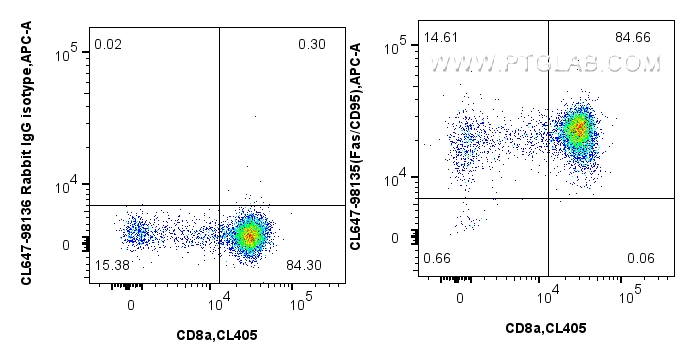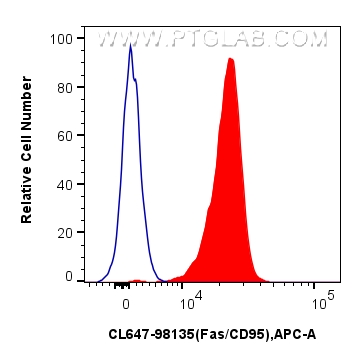验证数据展示
经过测试的应用
| Positive FC detected in | mouse thymocytes |
推荐稀释比
| 应用 | 推荐稀释比 |
|---|---|
| Flow Cytometry (FC) | FC : 0.25 ug per 10^6 cells in 100 μl suspension |
| This reagent has been tested for flow cytometric analysis. It is recommended that this reagent should be titrated in each testing system to obtain optimal results. | |
| Sample-dependent, Check data in validation data gallery. | |
产品信息
CL647-98135 targets Fas/CD95 in FC applications and shows reactivity with mouse samples.
| 经测试应用 | FC Application Description |
| 经测试反应性 | mouse |
| 免疫原 |
CatNo: Eg1376 Product name: Recombinant Mouse Fas/CD95 protein (rFc Tag) Source: mammalian cells-derived, pHZ-KIsec-C-rFc Tag: C-rFc Domain: 22-169 aa of NM_007987.2 Sequence: QGTNSISESLKLRRRVRETDKNCSEGLYQGGPFCCQPCQPGKKKVEDCKMNGGTPTCAPCTEGKEYMDKNHYADKCRRCTLCDEEHGLEVETNCTLTQNTKCKCKPDFYCDSPGCEHCVRCASCEHGTLEPCTATSNTNCRKQSPRNR 种属同源性预测 |
| 宿主/亚型 | Rabbit / IgG |
| 抗体类别 | Recombinant |
| 产品类型 | Antibody |
| 全称 | Fas (TNF receptor superfamily member 6) |
| 别名 | CD95, Fas, 241229C11, APO 1, APT1 |
| 计算分子量 | 37kDa |
| GenBank蛋白编号 | NM_007987.2 |
| 基因名称 | Fas/CD95 |
| Gene ID (NCBI) | 14102 |
| 偶联类型 | CoraLite® Plus 647 Fluorescent Dye |
| 最大激发/发射波长 | 654 nm / 674 nm |
| 形式 | Liquid |
| 纯化方式 | Protein A purification |
| UNIPROT ID | P25446 |
| 储存缓冲液 | PBS with 0.09% sodium azide, pH 7.3. |
| 储存条件 | Store at 2-8°C. Avoid exposure to light. Stable for one year after shipment. |
背景介绍
Fas (CD95/APO-1) is a transmembrane glycoprotein belonging to the tumor necrosis factor (TNF) receptor superfamily. It can mediate apoptosis by ligation with an agonistic anti-Fas antibody or Fas ligand. Stimulation of Fas results in the aggregation of its intracellular death domains, leading to the formation of the death-inducing signaling complex (DISC). FAS-mediated apoptosis may have a role in the induction of peripheral tolerance, in the antigen-stimulated suicide of mature T-cells, or both. The molecular mass of native Fas is 38 kDa, the high molecular weight form (40-55 kDa) of Fas is due to glycosylation.
实验方案
| Product Specific Protocols | |
|---|---|
| FC protocol for CL Plus 647 Fas/CD95 antibody CL647-98135 | Download protocol |
| Standard Protocols | |
|---|---|
| Click here to view our Standard Protocols |



